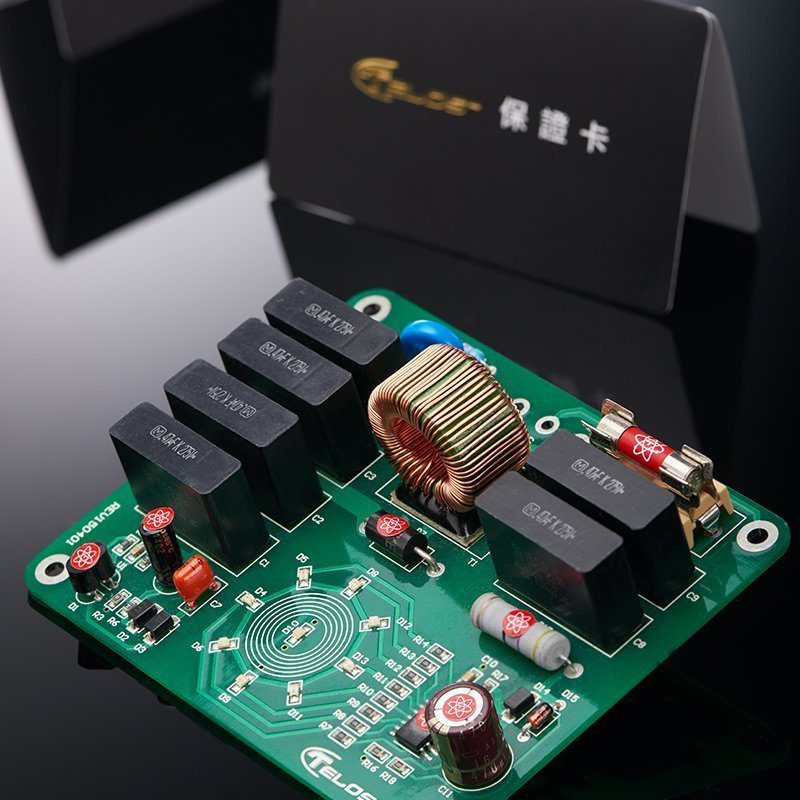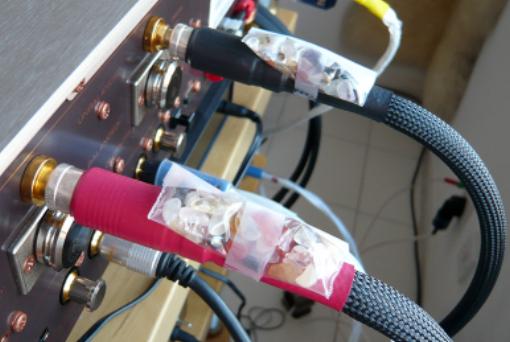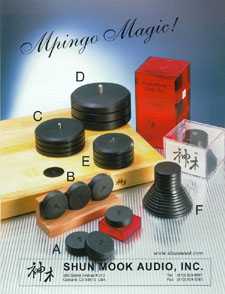The HiFi world is notorious as an industry rife with superstitions, outlandish claims, and broken promises. It’s a realm where the pursuit of pristine sound often collides with the allure of pseudoscience and the mystical. In this article, we dive into some of the most eyebrow-raising products on the market—from quantum stickers that claim to declutter your decibels, to mystical pebbles meant to melodize your music room.
Quantum Stickers: Sticking It to Reason

Welcome to the audacious world of Quantum Stickers, where physics meets fiction in a hi-fi enthusiast’s fever dream. Championed by Telos Quantum X2, these little adhesives promise to do for your sound system what spinach does for Popeye—give it a superhuman boost. But before you peel, stick, and revel in auditory bliss, let’s dissect this sticky proposition.
The Science (Sort of)
At the heart of Quantum Stickers lies a pitch that could only be conjured up in a mad scientist’s lab—or perhaps a marketer’s feverish brainstorm. Jeff Lin, the mastermind behind Telos, claims these stickers use quantum techniques and far-infrared technology to refine your audio experience. How? By supposedly tuning your system’s electronic and physical properties right from the surface of your capacitors to the soul of your resistors.
Unwrapping the Magic
These stickers are touted as the Swiss Army knife of audio enhancement: they battle electrostatic discharge, optimize efficiency, and purportedly clear up your sound like Marie Kondo tidying a cluttered room. The secret ingredient? A blend of far-infrared elements and anion ores, which sound impressive—if you’re manufacturing semiconductors or maybe baking up some science fiction.
When it comes to actual, measurable improvement, the sound of silence from the scientific community is deafening. The enhancement users report could well be attributed to the placebo effect—a sonic sugar pill, if you will. After all, when you’ve just stickered up your system with the quantum equivalent of a superhero cape, every note might seem to fly a little higher and hit a little harder.
Experts in audio tech and acoustics tend to sing a different tune—a tune that’s less about quantum leaps and more about grounded, boring reliability. Testing these stickers in controlled, bias-free environments reveals a consistent result: the only thing these stickers alter is your perception, not your sound. They’re perfect for placebo aficionados or those looking to jazz up the aesthetics of their cables with a pricey sticker.

Peeling Off the Hyperbole
Quantum Stickers seem less about quantum physics and more about quantum leaps of faith. They’re a testament to the power of marketing, capable of dressing up an ordinary adhesive with the allure of cutting-edge science. For audiophiles seeking true enhancement, your money might be better spent on tangible upgrades—like actual speakers, perhaps.
Find out more on their website!
The Teleportation Tweak: A Quantum Leap or Just a (Jedi) Mind Trick?
Step right up, folks, to witness the marvel of the Teleportation Tweak, an audacious blend of quantum physics, mystical fields, and what appears to be sheer telephonic wizardry. Conceived by Geoff Kait of Machina Dynamica, this tweak promises to enhance your audio and video systems through nothing more than a phone call. Yes, you read that right—a phone call. Let’s unpack the “science” behind this miraculous intervention and decide whether it’s a groundbreaking discovery or just a case of audio placebo.

Dial M for Magic
The Teleportation Tweak operates on the principle of “Information Fields”—a concept as nebulous as it is fascinating. Kait suggests that all objects (and presumably, their digital and electronic representations) generate an “information field” which, thanks to morphic resonance, can influence similar objects around the globe without decay over distance. Your home’s electronics, from your humble cellphone to your sleek TV, are not just gadgets but portals to a vast web of information fields that purportedly degrade your audio-visual experience.
Here’s where it gets Hollywood: Kait’s process doesn’t involve mere frequency sweeps or demagnetizing signals, oh no. He employs a landline or cellphone to remotely adjust these fields, claiming that even a switched-off phone can channel quantum effects directly into your sound system. The tweak involves mysterious “clicking through” procedures that “change the matter of the phone” in ways that are as unspecified as they are unbelievable.
Kait draws on Rupert Sheldrake’s theory of morphic fields, which suggests that forms in nature inherit a collective memory from all similar forms past. While an intriguing theory in the realm of speculative biology, its application to audio equipment enhancement is, to put it mildly, a creative leap.
Exotic Phones and Information Overload
Customers of the Teleportation Tweak report enhancements in sound clarity, dynamics, and spatial qualities—improvements that, interestingly, require no system to be physically modified or even turned on. This raises the eyebrow: are we experiencing a breakthrough in quantum mechanics, or is this a classic case of the placebo effect enhanced by the mystique of quantum language?
One particularly bold claim is that the tweak not only enhances audio systems but also boosts cell phone reception and performance by making them “exotic.” This term seems to be a euphemism for making your phone uniquely immune to the pervasive, performance-sapping information fields—a concept that sounds more like science fiction than science fact.
Skepticism in the Air(waves)
The Teleportation Tweak, with its blend of quantum entanglement and morphic resonance, is either a revolutionary discovery or a masterful illusion. For audiophiles and skeptics alike, the tweak serves as a fascinating case study in the power of suggestion and the allure of pseudo-scientific jargon. While it might not hurt to take a call (except perhaps to your wallet), one should dial in with a healthy dose of skepticism.
Find out more about this revolutionary technology here and here!
The Green Marker Tweak: Audiophile Alchemy or Just a Colorful Tale?
In the eclectic world of audiophile tweaks, one of the most colorful (literally) and debated tricks is the Green Marker Tweak. Here, the claim is as simple as it is bizarre: drawing a green line around the edge of a CD with a felt-tip marker can enhance sound quality by reducing laser scatter. So, let’s grab our markers and explore whether this tweak is a stroke of genius or just a smudge on the face of audio science.

A Brush with Science
The theory behind the Green Marker Tweak sounds like it could have been conceived during a particularly imaginative arts and crafts session. Proponents argue that the green ink interacts with the laser light used to read CDs, reducing read errors and thus improving sound quality. At first blush, this seems plausible enough—after all, we’re just talking about light and colors, right? But as we delve deeper, the scientific backing appears to be as thin as the ink itself.
Several enterprising souls have taken it upon themselves to test the Green Marker Tweak under controlled conditions. The results? Unsurprisingly, they find that while the marker might change the aesthetic of your CD collection, it does little to alter the data integrity or sound quality. Digital data, particularly on a commercial CD, is encoded in such a way that small read errors (which are inevitable, green ink or not) are corrected by the player’s error-correction algorithms. The audio remains unchanged, as the digital-to-analog conversion process faithfully reproduces the original sound, unaffected by the color of the disc’s edge.
The persistence of the Green Marker Tweak in audiophile circles can largely be attributed to the placebo effect. When a listener believes that they’ve made a change that should improve sound quality, their brain is remarkably good at convincing them that the sound has indeed improved. This psychological phenomenon is powerful, particularly in subjective areas like audio perception.
Anecdotal evidence from individuals who swear by the tweak continues to fuel its popularity. However, when these claims are subjected to blind testing—where the listener doesn’t know if they’re hearing a ‘greened’ CD or not—the miraculous improvements tend to disappear. This strongly suggests that the tweak’s supposed benefits are more a matter of perception than of acoustic reality.
A Spectrum of Beliefs
The Green Marker Tweak stands out as a vivid example of how folklore can infiltrate even the high-tech world of audio equipment. For those looking for a cost-effective way to potentially placebo their way to better sound, a green marker is a small investment. But for the scientifically minded, it’s clear that this tweak is more about adding flair to your CD collection than function.
Unconvinced? This article has all the graphs and science to back it up!
Brilliant Pebbles: The Stones That Stir Souls or Just Sink Sound?
In the mystifying world of high-fidelity audio enhancements, Machina Dynamica’s Brilliant Pebbles is a standout—a tweak that literally rocks the audiophile community. Promoted as an essential tool for tuning room acoustics and audio systems, these pebbles aren’t just any garden-variety stones. They’re sold with the promise of refining the sonic landscape of your listening environment. But does this curious concoction of minerals and marketing really amplify the audio experience, or is it merely a placebo piling up in the corners of audiophile lore?

The Pebble Pitch
The concept behind Brilliant Pebbles is simple yet profound: strategically placed stones can influence sound by interacting with acoustic energies in the room. According to Machina Dynamica, these aren’t just rocks; they’re meticulously selected minerals, each with a supposed unique property that enhances sound by absorbing, reflecting, or otherwise manipulating invisible energy fields within a listening space.
The science—or lack thereof—behind Brilliant Pebbles relies heavily on the esoteric principle of “sympathetic resonance.” This concept suggests that objects within the same space can influence each other’s vibration patterns through the air, an idea that finds more credibility in metaphysical circles than in empirical acoustical engineering. While it’s true that room acoustics play a crucial role in audio quality, the notion that small stones can significantly alter these dynamics is, to put it lightly, a hard pill—or pebble—to swallow.
When put to the test under controlled conditions, the results are less than earth-shattering. Objective measurements using sophisticated audio equipment generally show no significant change in sound quality or room acoustics attributable to the presence of these pebbles. Yet, the subjective nature of audio perception keeps the door open for personal testimonies that sing praises of clearer highs and deeper lows, courtesy of these mystical minerals.
A Rock and a Hard Place
Brilliant Pebbles occupy a curious niche in the audiophile world, one that straddles the delicate line between innovative audio solution and imaginative folklore. For enthusiasts who revel in the ritualistic aspect of setting up their sound systems, these pebbles offer a tangible (and quite literal) touchstone to engage with their passion for perfect sound. Yet, for the skeptics and scientifically minded, they serve as a reminder that not all that glitters in the audiophile market is gold—or even remotely scientifically sound.
This is not your grandma’s pebbles.
The $485 Volume Knob: A Turn for the Better or Just Priced to Deter?
In the high-end world of audiophile equipment, where every component is scrutinized for its impact on sound quality, the $485 volume knob from Silver Rock stands out—not just for its function, but for its audacious price tag. Promising to enhance audio dynamics and the overall naturalness of sound by dampening “micro vibrations,” this knob invites us to turn up our expectations. But does it really dial up the audio experience, or is it simply a case of cost inflating the perceived value?

Turning Up the Science
The premise behind this pricey knob is that it can reduce micro-vibrations—those tiny, pesky disturbances generated by the volume control mechanism itself—that supposedly seep into the audio signal path and degrade sound quality. Crafted from a mix of exotic materials like wood, bronze, and special lacquer, Silver Rock claims these knobs are tuned to the right frequency to counteract these vibrations, thereby clearing up the audio output.
To the scientifically inclined, the notion that a volume knob, no matter how finely crafted, can significantly alter sound quality by mitigating micro vibrations might sound, well, a bit over-rotated. In the digital era, where the vast majority of audio signals are processed and amplified without any analog interference until the final conversion stages, the physical interface (like a volume knob) plays little to no role in sound alteration.
Audiophile forums and gadget tests often indulge in the evaluation of such accessories, and the results are typically mixed. While some users report a noticeable enhancement in sound clarity and depth, rigorous blind testing (where the identity of the knob is concealed) seldom confirms these findings. This lack of consistent, verifiable evidence suggests that any improvements might be more psychological than acoustic—a classic case of expectation influencing perception.
At $485, this knob ventures into the territory of luxury rather than functionality. It’s worth considering whether the investment is paying for a genuine audio improvement or simply the allure of owning a high-priced, meticulously marketed piece of equipment. For some, the tactile pleasure and aesthetic enhancement of such a finely crafted object might be worth the price alone, regardless of its actual impact on sound.
A High-End Twist on Placebo
In conclusion, the Silver Rock volume knob is a perfect illustration of the high-fidelity audio market’s penchant for opulence and exclusivity. While it may not harm your audio setup (and might even add a touch of class), the actual benefits to sound quality are up for debate. In the symphony of sound equipment, this knob may not be the most critical instrument, but it certainly plays into the desires and dreams of those who wish to leave no stone—or knob—unturned in their quest for the perfect audio setup.
The Magic of Mpingo: Harmonic Harmony or Hardwood Hype?
Diving deeper into the world of high-fidelity audio, one encounters the mystical Mpingo discs from Shun Mook, a name that evokes both curiosity and skepticism in the audiophile community. Made from a combination of Gaboon and Mpingo ebony, these discs are touted as essential for harnessing and regulating sonic resonance in any audio setup. But does the magic of Mpingo truly enhance the listening experience, or is it merely a case of sonic snake oil?

The Lore of Mpingo
Mpingo, or African blackwood, has long been prized for its density and acoustic properties, famously used in woodwind instruments like clarinets and oboes. Shun Mook’s claim extends this natural resonance to the realm of audio playback. By placing Mpingo discs atop (yes, atop) speakers, CD players, or amplifiers, the company asserts that these wooden wonders can influence the sound field, enriching the audio output with clearer, more natural tones.
The science behind Mpingo discs hinges on the concept of “sympathetic resonance,” a phenomenon where objects sharing similar sonic characteristics can influence each other’s vibration states. While this is a genuine physical effect—albeit primarily in musical instrument construction—the leap to audio enhancement involves a degree of conjecture that many engineers and scientists find too far-fetched for comfort.
Objective testing of Mpingo discs in controlled acoustic environments yields inconclusive results. Some listeners report a more defined soundstage, improved dynamics, and a warmer tone, while others detect no difference. This disparity may be attributed to the subjective nature of sound perception, heavily influenced by expectation and individual auditory sensitivity.
At a significant cost for what are essentially small pieces of wood, Mpingo discs are an investment in potential auditory improvement that doesn’t guarantee measurable returns. This high entry fee raises questions about the value of the discs versus the placebo effect, where the belief in the product’s efficacy might itself enhance enjoyment—a not insignificant psychological factor in the appreciation of music.
The Enigmatic Efficacy of Mpingo
Mpingo discs stand at the crossroads of acoustic science and audiophile alchemy. For those who believe, these ebony discs offer a tangible connection to the natural world’s resonant magic, potentially unlocking new dimensions in favorite tracks. For the skeptics, Mpingo serves as yet another reminder that in audio, as in life, beauty—and sound—is often in the ear of the beholder.
Learn more about the magic of Mpingo here.
Conclusion
That’s it, folks! We’ve journeyed through the labyrinthine world of high-fidelity audio tweaks—from the quantum mystique of stickers and the arcane arts of pebbles to the venerable veneer of Mpingo discs and the luxe life of a $485 volume knob. Each product, with its promises of sonic salvation, invites both awe and scrutiny in equal measure.
As we’ve seen, the line between genuine audio enhancement and the power of suggestion is as fine as a needle on a vinyl record. Whether these products offer a real acoustic advantage or serve as expensive placebos, they all share one thing in common: they spark debate and cater to the ceaseless pursuit of perfect sound that drives the audiophile community.
So, whether you’re a skeptic who keeps your audio setup strictly scientific or a believer in the mystical power of high-end tweaks, there’s no denying that the quest for perfect audio is never dull. Keep your ears open, your mind curious, and, perhaps most importantly, keep enjoying the music. After all, whether it’s through a sticker, a stone, or a piece of carefully crafted ebony, the joy of listening remains the truest test of all. Happy tuning!






Leave a Reply